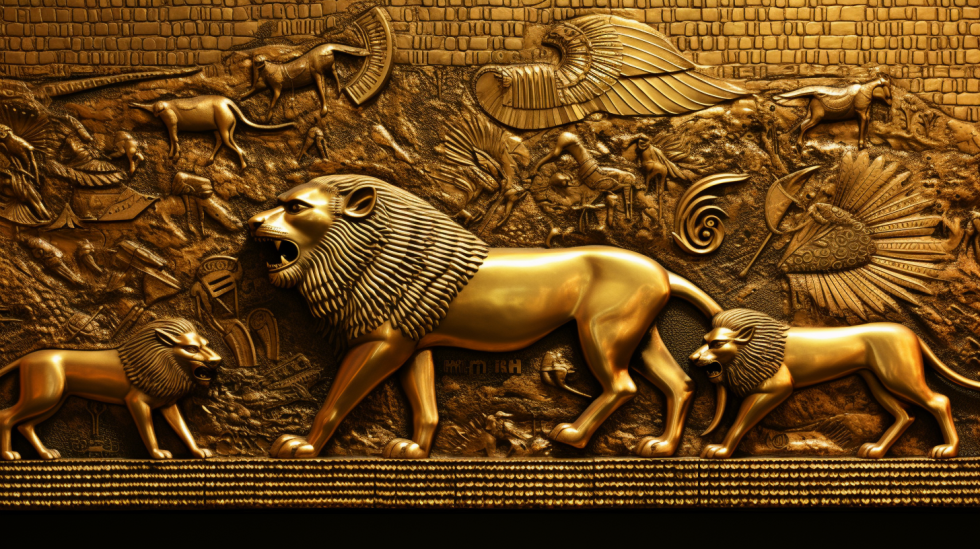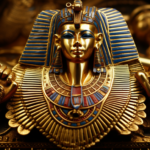Ancient Mesopotamia, often referred to as the “cradle of civilization,” was a region of great innovation and cultural development. Among the treasures that adorned this ancient land, gold held a special place. Gold was more than just a symbol of wealth; it was deeply intertwined with the religious, economic, and artistic aspects of Mesopotamian society. In this exploration of “Gold in Ancient Mesopotamia,” we will uncover the role of gold in the early civilizations of Sumer, Akkad, and Babylonia, its cultural significance, and the legacy it left behind.

The Mesopotamian Cradle of Civilization
Mesopotamia, located in the fertile region between the Tigris and Euphrates Rivers (modern-day Iraq and parts of Iran, Turkey, and Syria), was home to some of the earliest human settlements. The Mesopotamian civilizations, including Sumer, Akkad, and Babylonia, laid the foundations for urbanization, writing systems, and complex societies. Amidst this cultural blossoming, gold played a prominent role.
Gold in the Sumerian Civilization
1. Early Records of Gold Use: The Sumerians, one of the earliest civilizations in Mesopotamia, left behind clay tablets dating back to around 3000 BCE that document the use of gold for various purposes. These records include references to gold as a form of currency and a medium of exchange.
2. Religious Significance: Gold held significant religious importance for the Sumerians. It was associated with the divine and used in the construction of temples and statues of deities. Gold was seen as a symbol of the gods’ favor and a means of connecting with the divine.
3. Adornments and Jewelry: Gold jewelry was popular among the Sumerians. They crafted intricate necklaces, bracelets, and headdresses using gold, often adorned with gemstones and intricate designs. Gold jewelry was worn by both the elite and common people.
4. Trade and Economy: Gold served as a form of currency in Sumerian society. It was used for trade and as a measure of value for various commodities. The standard weight for gold in trade was the shekel, a unit that later became standardized in the ancient Near East.
5. Funerary Practices: Gold played a role in Sumerian funerary practices. The elite were buried with gold jewelry and ornaments to accompany them in the afterlife, reflecting a belief in the value of gold in the realm beyond.
Gold in the Akkadian Empire
1. Economic Powerhouse: The Akkadian Empire, founded by Sargon of Akkad in the 24th century BCE, became a dominant force in Mesopotamia. Gold continued to be a crucial component of the empire’s economy and trade networks.
2. Architectural Marvels: The Akkadian rulers, including Sargon and his successors, used gold to adorn and enhance their architectural marvels. Temples and palaces featured gold leaf, inscriptions, and ornamentation, showcasing the empire’s wealth and power.
3. Royal Tombs: Some of the most significant finds related to gold in the Akkadian period are the royal tombs of the rulers. These tombs contained valuable gold artifacts, such as crowns, jewelry, and ceremonial objects, which exemplified the opulence of the rulers.
4. Influence on Later Empires: The Akkadian Empire’s use of gold and its sophisticated administrative systems influenced later empires, including Babylonia and Assyria. The Akkadian shekel, a gold standard of weight and value, continued to be used in trade.
Gold in the Babylonian Empire
1. Hammurabi’s Code: The Code of Hammurabi, one of the most famous legal codes in history, includes provisions related to gold and property. It regulated issues such as debt repayment, contracts, and the use of gold as currency.
2. Royal Use: The Babylonian rulers, particularly during the Neo-Babylonian Empire, continued to employ gold extensively. The famous Ishtar Gate, part of Nebuchadnezzar II’s Babylon, featured exquisite golden tiles and artistic embellishments.
3. Currency and Trade: Gold remained a vital currency and medium of exchange in the Babylonian Empire. It facilitated trade both within the empire and with other regions, including Egypt and the Levant.
4. Religious Artifacts: Gold was used to craft religious artifacts, including statues of deities, temple adornments, and offerings. It played a role in temple rituals and offerings to the gods, reflecting its sacred status.
The Legacy of Gold in Mesopotamia
The significance of gold in ancient Mesopotamia extends beyond its material value. It left a lasting legacy that influenced subsequent civilizations and shaped the understanding of wealth, power, and cultural identity. Here are some aspects of gold’s legacy in Mesopotamia:
1. The Standardization of Currency: The concept of using a standard unit of weight for gold, the shekel, was developed in Mesopotamia and continued to be used by subsequent civilizations in the ancient Near East.
2. Architectural and Artistic Influence: The use of gold in Mesopotamian architecture and art set a precedent for later empires, including the Persians, Greeks, and Romans. The opulence of Mesopotamian palaces and temples influenced the aesthetics of monumental structures.
3. Cultural Identity: Gold became intertwined with the cultural identity of Mesopotamia. Its use in religious practices, jewelry, and funerary rituals reflected the importance of gold in both spiritual and secular aspects of life.
4. Legal and Economic Systems: The inclusion of gold-related laws in the Code of Hammurabi and the use of gold as currency influenced the development of legal and economic systems in subsequent civilizations. The legacy of these systems, including standardized weights and measures, endured for centuries.
5. Iconography and Symbolism: Symbols and motifs associated with gold, such as the sun disk and divine crowns, continued to hold significance in later cultures and religious traditions. The use of gold as a symbol of divinity persisted.
6. Historical Records: The extensive clay tablets and inscriptions from Mesopotamia provide valuable historical records of gold’s use, trade, and cultural significance. These records continue to be studied by historians and archaeologists, offering insights into the past.
Challenges and Decline
While gold played a pivotal role in the ancient Mesopotamian civilizations, it also faced challenges and eventual decline:
1. Resource Depletion: Over time, the easily accessible sources of gold in the region became depleted. This led to a decline in gold production, which, coupled with increased demand, contributed to challenges in maintaining the supply of gold.
2. Invasions and Conflicts: Invasions and conflicts, such as those during the fall of the Akkadian Empire and the subsequent rise of various dynasties, disrupted trade networks and economic stability. This had an impact on the availability and circulation of gold.
3. Changing Empires: As empires rose and fell in Mesopotamia, the cultural and political landscape evolved. The use of gold in art and architecture shifted with changing dynasties and rulers.
4. Transition to Other Forms of Wealth: As societies evolved and urbanized, forms of wealth beyond gold, such as land ownership and agricultural production, gained increasing importance. The role of gold in the economy shifted as new forms of wealth emerged.
Conclusion: The Gilded Legacy Lives On
The gilded legacy of gold in ancient Mesopotamia serves as a testament to the enduring allure of this precious metal and its profound influence on culture, trade, and artistic expression. Gold in Mesopotamia was more than just a symbol of wealth; it was a reflection of the complex web of religious, economic, and social forces that shaped the cradle of civilization.
As we look back on the rich history of gold in Mesopotamia, we recognize its role as a symbol of divine favor, a medium of exchange, and an artistic medium that transcended time and place. Its legacy lives on not only in the artifacts and inscriptions of ancient Mesopotamia but also in the enduring fascination with gold that spans cultures and millennia.
The glittering wealth of Mesopotamia, as embodied by gold, continues to inspire and captivate. It reminds us of the profound impact that a single element can have on the course of history, the shaping of cultures, and the enduring quest for beauty and significance.



